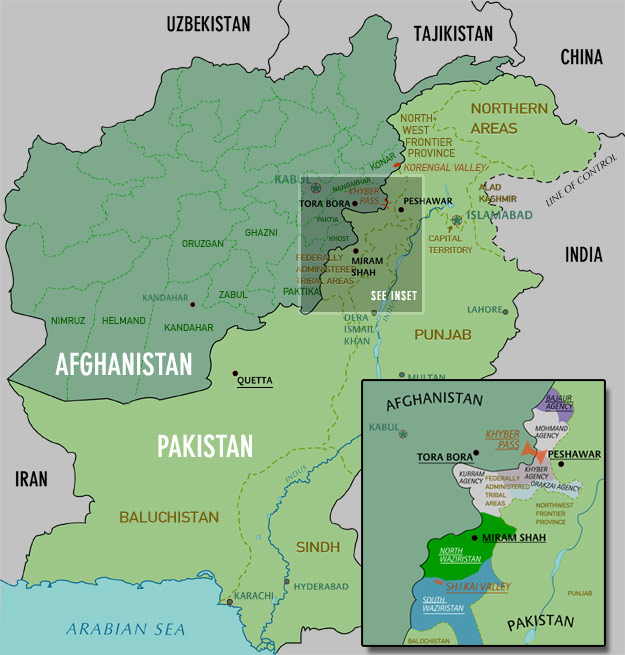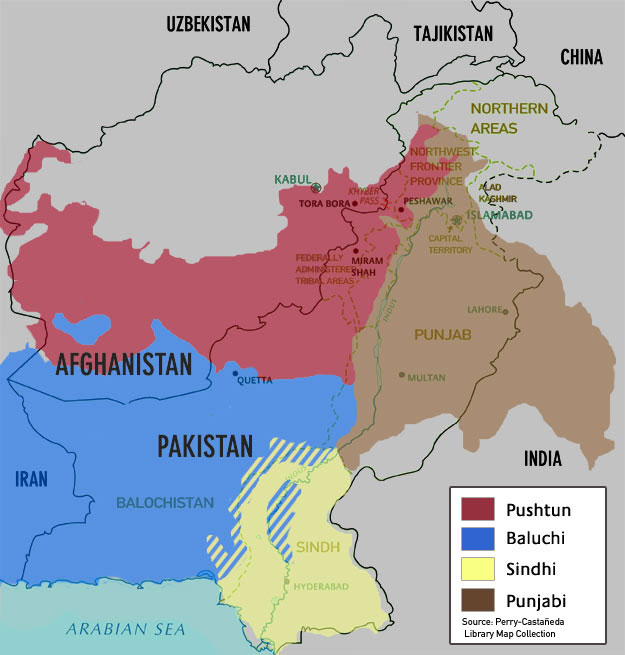Afghanistan's Korengal Valley -- located roughly north of Peshawar, Pakistan -- is the scene of some of the fiercest fighting in the tribal area during 2008.
For centuries the wild tribal area -- stretching 500 miles along the Afghan border -- has been lawless, violent and remote. Today it is a breeding ground for jihad. Taliban and Al Qaeda militants use this area as a launching pad for attacks against neighboring Afghanistan -- and a training ground for terrorist attacks worldwide. It is an area of Pakistan the government doesn't control and it is off limits to the U.S. military and the CIA.
This map shows the seven districts, or agencies -- from Bajaur in the north to the Waziristans in the south. Click on the underlined text for details.

Quetta
This is the Pakistani city from which much of the Taliban insurgency is being directed. Because it's close to the Afghan border, it is a launching point for cross-border attacks. Afghan intelligence believes Mullah Omar, the Taliban's supreme leader, is here.
South Waziristan
Intelligence analysts call South Waziristan the new headquarters for Al Qaeda's global operations. Pakistani military operations have been focused here because terror plots and assassination attempts on President Musharraf have been traced to the area. The Taliban have killed more than a hundred tribal elders in South Waziristan because they were suspected of cooperating with Americans or the Pakistan government.
Watch the section of the film on Waziristan - video chapter 2.
Shikai Valley
Home to the charismatic Taliban leader Nek Mohammed, this area has seen some of the fiercest fighting between militants and Pakistani soldiers, as well as the brokering of a 2004 peace deal. Mohammed agreed to lay down arms and register all Al Qaeda militants in the area, which was home to several Al Qaeda training camps. The treaty broke down almost immediately; Mohammed and several pro-government tribal elders who had brokered the deal were killed in the following months.
North Waziristan
Pakistani soldiers stationed here have faced nightly attacks from the Taliban. North Waziristan is also the base of Jalaluddin Haqqani, an architect of Taliban attacks in southern Afghanistan. And, in December 2005, Abu Hamza Rabia, a key Al Qaeda operative, was killed here in an American airstrike. For now, the United States remains on the Afghan side of the border. In September 2006, they ordered 7,000 more troops into the area opposite North Waziristan.
Watch the section of the film on Waziristan - video chapter 2.
Bajaur Agency
This area is believed to be a new base for Al Qaeda and the most likely location for bin Laden and his deputy Ayman al-Zawahiri, but the Pakistan army has almost no troops deployed here. Damadola village was the site of a January 2006 U.S. missile strike targeting Zawahiri. He escaped, but 18 people were killed, including four Al Qaeda operatives. Zawahiri appeared in a video two weeks later, taunting, "Bush, do you want to know where I am?"
Watch the section of the film on Bajaur - video chapter 6.
Miram Shah
In the summer of 2006 the Taliban took over this city, the capital of North Waziristan, and held it for three days. Pakistani officials say hundreds of Al Qaeda militants are also harbored here. In September 2006, the Pakistani government signed an accord here with tribal leaders -- many aligned with Al Qaeda and the Taliban -- calling for a halt to fighters crossing into Afghanistan and to attacks on Pakistani forces. Pakistan pledged to cease military operations against the militants. Critics say the deal will give the militants more freedom to operate.
Peshawar
Peshawar, Pakistan's oldest city, is gateway to the Khyber Pass and capital of Pakistan's Northwest Frontier. It has long been a center for drug smugglers, gun runners and jihadists. Peshawar was the birthplace of Al Qaeda in the 1980s and today it is a new base of operations for the Taliban. The Taliban's influence is increasingly apparent: billboards are censored, and women on the streets are fully covered. The western end of the city marks the entrance to Pakistan's tribal lands.
Khyber Pass
Over the centuries it has been an historic border passage between Pakistan and Afghanistan. In the 1980s it was a gateway for Afghan refugees fleeing the Soviet invasion. Today, it is crossing point for militants coming from Pakistan to fight coalition forces in Afghanistan.
Tora Bora
In December 2001, Osama bin Laden and his fighters were holed up in the mountains of Tora Bora. U.S. strategy depended on getting the Pakistanis to man their side of the border. But Pakistani troops were diverted -- Islamic militants had attacked India's parliament and neighboring India threatened war against Pakistan. Bin Laden escaped and many of his fighters crossed unimpeded into Waziristan.



